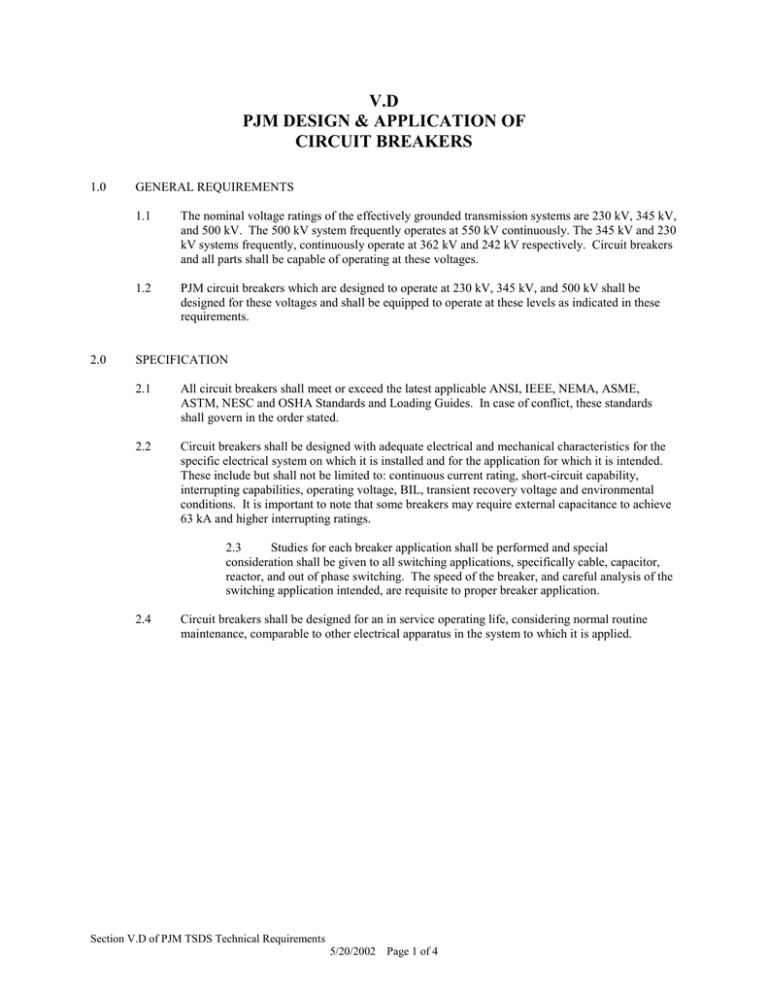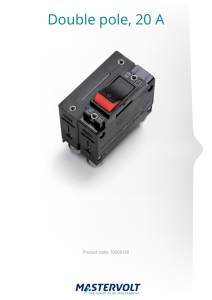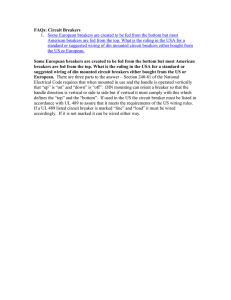Circuit Breakers
advertisement

V.D PJM DESIGN & APPLICATION OF CIRCUIT BREAKERS 1.0 2.0 GENERAL REQUIREMENTS 1.1 The nominal voltage ratings of the effectively grounded transmission systems are 230 kV, 345 kV, and 500 kV. The 500 kV system frequently operates at 550 kV continuously. The 345 kV and 230 kV systems frequently, continuously operate at 362 kV and 242 kV respectively. Circuit breakers and all parts shall be capable of operating at these voltages. 1.2 PJM circuit breakers which are designed to operate at 230 kV, 345 kV, and 500 kV shall be designed for these voltages and shall be equipped to operate at these levels as indicated in these requirements. SPECIFICATION 2.1 All circuit breakers shall meet or exceed the latest applicable ANSI, IEEE, NEMA, ASME, ASTM, NESC and OSHA Standards and Loading Guides. In case of conflict, these standards shall govern in the order stated. 2.2 Circuit breakers shall be designed with adequate electrical and mechanical characteristics for the specific electrical system on which it is installed and for the application for which it is intended. These include but shall not be limited to: continuous current rating, short-circuit capability, interrupting capabilities, operating voltage, BIL, transient recovery voltage and environmental conditions. It is important to note that some breakers may require external capacitance to achieve 63 kA and higher interrupting ratings. 2.3 Studies for each breaker application shall be performed and special consideration shall be given to all switching applications, specifically cable, capacitor, reactor, and out of phase switching. The speed of the breaker, and careful analysis of the switching application intended, are requisite to proper breaker application. 2.4 Circuit breakers shall be designed for an in service operating life, considering normal routine maintenance, comparable to other electrical apparatus in the system to which it is applied. Section V.D of PJM TSDS Technical Requirements 5/20/2002 Page 1 of 4 2.5 The following ratings apply to 500 kV circuit breakers installed on the 500 kV system: 2.5.1. 2.5.2. 2.5.3. Voltage Class Maximum Rated Voltage BIL (phase to phase, phase to ground, and across open gap) 1800(kV peak minimum) 500 kV 550 kV Circuit breaker BIL shall be carefully selected based on system studies, insulation coordination, and surge protection provided. Consideration shall be given to insulation capabilities to ground and insulation capability across an open breaker. BIL must be carefully selected to avoid open breaker flashover. 2.6 The following ratings apply to 345 kV circuit breakers installed on the 345 kV system: 2.6.1. Voltage Class 345 kV 2.6.2. Maximum Rated Voltage 362 kV 2.6.3. BIL (phase to phase, phase to ground, and across open gap) 1300 (kV peak minimum) Circuit Breakers BIL shall be carefully selected based on system studies, insulation coordination, and surge protection provided. Consideration shall be given to insulation capabilities to ground and insulation capability across an open breaker. BIL must be carefully selected to avoid open breaker flashover. 2.7 The following ratings apply to 230 kV circuit breakers installed on the 230 kV system: 2.7.1 Voltage Class 230 kV 2.7.2 Maximum Rated Voltage 242 kV 2.7.3 BIL (phase to phase, phase to ground, and across open gap) 900 kV (kV peak minimum) Circuit Breakers BIL shall be carefully selected based on system studies, insulation coordination, and surge protection provided. Consideration shall be given to insulation capabilities to ground and insulation capability across an open breaker. BIL must be carefully selected to avoid open breaker flashover. 2.8 All 500 kV, 345 kV, and 230 kV circuit breakers shall have dual independent trip coils. Section V.D of PJM TSDS Technical Requirements 5/20/2002 Page 2 of 4 3.0 APPLICATION & SPECIAL CONSIDERATIONS 3.1 Local environmental conditions should be considered when selecting creep requirements for circuit breaker bushings. 3.2 Circuit breakers, at a minimum, shall be designed to operate at ANSI required ambients of -22°F to +104°F (-30°C to +40°C). All circuit breakers shall be designed to operate satisfactorily in the ambients dictated at their installed location. Some locations in PJM have required -40°C capability. 4.0 MAINTENANCE 4.1 5.0 Circuit breakers shall be designed for an in service operating life, considering normal routine maintenance, comparable to other electrical apparatus in the system to which it is applied. For typical maintenance requirements, refer to Section V.L.2.D RATINGS 5.1 Ratings of electrical system apparatus, including circuit breakers, are critical to the reliable operation of the PJM system. Ratings of circuit breakers applied to the PJM system should be determined using the PJM TSDS guide "Guide for Determination of Circuit Breaker Load Current Capability Ratings" latest revision. Section V.D of PJM TSDS Technical Requirements 5/20/2002 Page 3 of 4 Section V.D of PJM TSDS Technical Requirements 5/20/2002 Page 4 of 4


